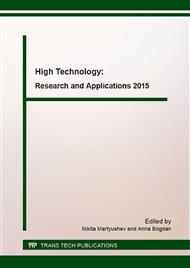[1]
E. E. Rogachev, M. V. Polonik, O. V. Dudko and E. V. Murashkin, Numerical Modeling of Forming a Preform under High Temperature Creep, Advanced Materials Research Trans Tech Publications, Switzerland 1040 (2014) 898-902.
DOI: 10.4028/www.scientific.net/amr.1040.898
Google Scholar
[2]
V. I. Gorelov, Effects of high pressures on mechanical characteristics of aluminum alloys, Journal of Applied Mechanics and Technical Physicsn 25 (1984), 813-814.
Google Scholar
[3]
E. H. Lee, Elastic-plastic deformation at finite strains, Journal of Applied Mechanics 36 (1969) 1-6.
Google Scholar
[4]
A. V. Shitikov and G. I. Bykovtsev, Finite Deformations in an Elastoplastic Medium, Dokl. Akad. Nauk SSSR 311 (1990) 59-62. [Sov. Phys. Dokl. (Engl. Transl. ) 35, 297 (1980)].
Google Scholar
[5]
O. T. Bruhns, A thermodynamically consistent Eulerian description of finite elastoplasticity, Key Engineering Materials 340-341 (2007) 787-794.
DOI: 10.4028/www.scientific.net/kem.340-341.787
Google Scholar
[6]
Yao Ying Huang, Hong Zheng and Yi Hong Zhou, Simulation analysis of concrete Dam's joints based on elastic-plastic creep model, Applied Mechanics and Materials 137 (2011) 243-249.
DOI: 10.4028/www.scientific.net/amm.137.243
Google Scholar
[7]
Wen Ling Chen and Fa Suo Zhao, Study on non-linear viscous elastic-plastic creep model of mica-quartzose Schist Applied Mechanics and Materials 157-158 (2012) 622-627.
DOI: 10.4028/www.scientific.net/amm.157-158.622
Google Scholar
[8]
Li Wu, Qing Jun Zuo and Zhong Le Lu, Study on the Constitutive Model of Visco-Elasticity-Plasticity Considering the Rheology of Rock Mass, Advanced Materials Research 639-640 (2013) 567-572.
DOI: 10.4028/www.scientific.net/amr.639-640.567
Google Scholar
[9]
E. Murashkin and M. Polonik, Development of Approaches to the Creep Process Modeling under Large Deformations Applied Mechanics and Materials 249-250 (2013) 833-837.
DOI: 10.4028/www.scientific.net/amm.249-250.833
Google Scholar
[10]
A. A. Bazhin and E. V. Murashkin, Creep and Stress Relaxation in the Vicinity of a Micropore under the Conditions of Hydrostatic Loading and Unloading, Doklady Physics Pleiades Publishing, Ltd. 57 (2012) 294-296.
DOI: 10.1134/s1028335812080095
Google Scholar
[11]
F. D. Murnaghan, Finite Deformations of an Elastic Solid, American Journal of Mathematics, 59 (1937) 235-260.
Google Scholar
[12]
A.A. Lapteva, O.V. Dudko, Distribution Regularities of Shear Deformations in Incompressible Nonlinear Elastic Solids, Advanced Materials Research, 1040 (2014), 864-869.
DOI: 10.4028/www.scientific.net/amr.1040.864
Google Scholar
[13]
F. H. Norton, Creep of Steel at High Temperatures, McGraw Hill, New York. (1929).
Google Scholar
[14]
T. G. Kolda, R. M. Lewis, and V. Torczon, Optimization by Direct Search: New Perspectives on Some Classical and Modern Methods, SIAM Review 45 (2003) 385–482.
DOI: 10.1137/s003614450242889
Google Scholar
[15]
J. C. Spall, Introduction to stochastic search and optimization: estimation, simulation, and control, John Wiley and Sons, (2003).
Google Scholar


